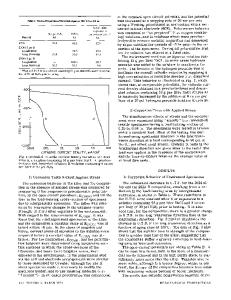Electrochemical Behavior of m -Nitrosulfonic Acid of Benzene in Aqueous Solutions of Different Composition
- PDF / 1,097,157 Bytes
- 11 Pages / 612 x 792 pts (letter) Page_size
- 44 Downloads / 440 Views
trochemical Behavior of m-Nitrosulfonic Acid of Benzene in Aqueous Solutions of Different Composition A. A. Konarev* State Research Center NIOPIK, Moscow, 123995 Russia *e-mail: [email protected] Received September 20, 2019; revised December 12, 2019; accepted March 3, 2020
Abstract—The electrochemical behavior of m-nitrosulphonic acid of benzene was studied by polarography, voltammetry at glassy carbon electrode, electrolysis at the controlled potential, and electrolysis in galvanostatic mode. A distinguishing feature of the m-nitrosulphonic acid of benzene electroreduction, as compared with that of aromatic nitro-compounds, both on mercury dropping electrode and glassy carbon electrode, is shown to be a strong dependence of parameters and shape of the polarization curve on the supporting electrolyte solution composition and рН in neutral and alkaline solutions. The two waves observed are bound to the reduction of undissociated m-nitrosulphonic acid of benzene molecule and its anion; the reduction intermediately product is hydroxylaminesulphonic acid of benzene. The wave of its further reduction to m-aminosulfonic acid of benzene is camouflaged by the supporting-electrolyte discharge. Ammoniac-buffered solutions can be recommended for preparative electrosynthesis of m-aminosulfonic acid of benzene because its yield in the electrolysis at nickel cathode in galvanostatic mode in these solutions is as high as 92.8%, with current efficiency of 82.0%. Keywords: m-nitrosulfonic acid of benzene, m-aminosulfonic acid of benzene, polarography, voltammetry on glassy carbon electrode, microelectrolysis, electrolysis at controlled potential DOI: 10.1134/S1023193520090074
INTRODUCTION The benzene m-aminosulfonic acid (m-ASAB) is used in the manufacturing of azo-dyes [1]. The starting material in the m-ASAB industrial synthesis is nitrobenzene, which is sulphonated with oleum; thus obtained corresponding benzene m-nitrosulfonic acid (m-NSAB) is neutralized with powder chalk in the presence of sodium carbonate, then reduced, as a sodium salt in concentration of 140–180 g/L, with cast-iron turnings ammoniac-alkaline solution at the boiling temperature [2]. Upon the reduction, the reaction mass is neutralized with caustic ash up to рН 7.5– 8.0, filtered, and boiled-down to the m-ASAB concentration of 225–250 g/L. The target product is worked up from the solution by acidifying of the amine solution with concentrated sulfuric acid down to рН 1.5–2.0. The m-ASAB final yield for the reduction and product isolation from the solution came to 76.0%. The lack of the chemical method of m-ASAB preparation is its multistage and labor-consuming nature, a great deal of solid waste in the form of nonrecyclable iron spent slurry, and low purity of the target product. To improve and simplify the stage of the aromatic nitrosulfonic acid reduction, the progress is sought for by using two methods: catalytic hydrogenation and
electroreduction. In patent literature [3] a method is described how to manufacture aromatic aminosulfonic acids by ca
Data Loading...











